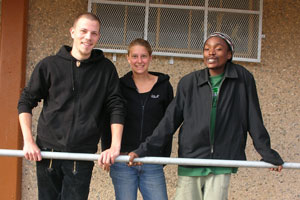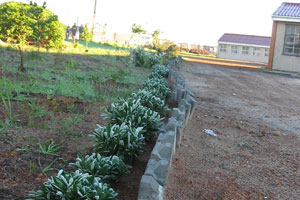|
Glen Tyler – the project manager from SEED suggested that we maybe could take one of the schools which had applied to get involved in another SEED project and didn´t get in already. So we decided to have a look at some schools. First was Nosisa, the volunteer from 2004 brought us to K1 Special School in Khayelitsha, who applied already two years ago for the Bauwagenproject but had lost interest at that time. This year they seemed to be involved in ecological matters – an environmental staff group existed and the nurse of the school was very keen to set up a vegetable garden. So the K1 Special School was our choice for the Bauwagenproject. K1 had just broken playground equipment and a sandy schoolyard. A lot had to be done! Because K1 is a school for disabled children it was a great challenge for us to work with these children. As soon as we made our choice we started meeting with the three teachers of the environmental group and the nurse who were keen to work with us in the project. We introduced them to the project and soon we could start with the planning. During two days we met the classes to ask the learners about their needs and wishes. After the participation phase with the learners, we sat together with our partners form SEED and started planning our time and draw some kind of a draft for the schoolyard. This was a hard piece of work for us because we had no experience with planning and the first month of our stay has passed by already! But at least we had a plan what to do. We had to start quickly with our work. A lot of preparations had to be done at the same time while other parts of the project were already going on … We had to work on the schoolgrounds, to buy the stuff we needed and to change our plans all at the same time! And often we had to change our proposed timetable and communicate this to the teachers.
The two of us from
During the month a lot happened. At the beginning we suggested to start our work after the school holidays, so that we could plan and prepare everything during the holidays. We were surprised, when the teachers suggested that they wanted to start working during the holidays. It was a big surprise because everyone had told us before, that we could do no work during the holidays! So one day we met the teachers, the nurse and some mothers and started to prepare the soil for the greening, we pulled out the grass and digged the soil. Because we could not finish our work in one day we continued with that work after the holidays with the learners. After this was done we spread compost and digged it into the soil and then we started planting. With all this we got some help from Nosisa. She was the one who had chosen the plants and told us how to prepare the soil. While we did all this we also had to build some high patches. We piled old tires, filled them with soil and planted some plants and herbs in it. When the garden was ready the teachers made different classes responsible for different parts of the garden and for the high patches. These classes had to look after the plants and had to water them regularly. As soon as we finished the garden-work, we started to focus on the playground equipment. We fixed the broken parts and together with the children we digged huge truck tires half into the soil. At the end it looked like a tunnel which was a lot of fun for the children. At the same time we created a small path through the garden, so that the learners could water the plants easier and at last we framed the whole garden with a fence of small stones. Despite all the work the learners were happy that they could help to make their schoolyard nicer and greener. They worked so hard, that sometimes we had to stop them. It was the worst thing while working with those children, that we could not understand them, because scarcely anyone spoke English. Either we needed a translator or we had to talk with hand, feet and stuff like this. We could not finish the fixing of all the playground equipment, because we could get a new swing only in the last week of our stay. So we focussed on another great wish of the learners and the teachers, the vegetable garden. Once again we had to dig and prepare the soil for plants. And again the teachers found some learners who are now responsible for the veggies. We created a nice vegetable patch which reminds one to the Scottish flag. But with just planting our work was not done. The vegetables had to be protected from the winds. So it was our task to build a wind breaker. The bushes we planted were too small to catch the wind, so we had to build a wall of tires as a protection against the wind. This tire-wall has two functions, as a wind breaker and as a patch for potatoes. The final work was done by companies. They built benches for an outdoor classroom, two see-saws and with their help we finally could also repair the swings.
For this project most of the funds were bound to something special like greening or just playground equipment: Abalimi: 11.000 ZAR for greening Aachen-CT-Partnerschip: 500 EUR for playground equipment Private donations: 800 EUR for playground equipment That was a problem for us. We think, that there should be just one budget for one project! As it is in the aims of the Bauwagen-project the wishes and needs of the learners are most important. If the children for example just want to have a green school yard and nothing else, all the money should be spend on greening. If they want to have just playground equipment, the Bauwagenteam has to build it. In our opinion it is against the aims of the project to fix the money on particular things so that the project team can not implement the wished of the children because there is no money for what they would like to have.
We needed a long time to get the knowledge about the responsibilities within the project. The role of Abalimi, SEED and Stadtoasen should be sorted out before the start of the next project. Honestly, this is in progress by creating a handbook. Thanks to Glen Tyler, he has been very helpful. He was around in the office every day and was automatically involved in the most issues. His help was important for us, also in the work with Abalimi. Every communication passed him and he was the contact person between the Bauwagenteam and all the other involved persons. Nearly till the end of the project we got to know that Nosisa is also an active part of our Bauwagenproject – we think a better communication between all the participants in the project is necessary to avoid a lot of misunderstandings. |
|||||||||||||||||||||||||





